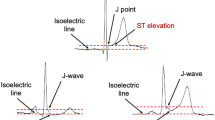Abstract
Purpose
Early repolarization (ER) has been considered a common benign ECG pattern among young athletes. In contrast, an inferolateral early repolarization pattern has been associated with an increased risk for sudden cardiac death (SCD). The aim of the study was to assess the prevalence of inferolateral ER among young collegiate athletes and to describe the characteristics associated to the pattern.
Methods
We analyzed ECGs from 503 athletes (51% males; age range, 17–24). Information on gender, body weight, race, sport, and family history of SCD was collected. ER was defined as a slow deflection of the down slope of the R wave (≥0.1 mV) or positive wave at J point (≥0.1 mV) in two consecutive inferior or in lateral leads. Additionally, we included voltage measurements according to the Sokolow–Lyon criteria and RR interval measurement.
Results
The prevalence of ER was 30% (inferior, 20%; lateral, 21%; both, 11%). Male gender (59% vs. 48%, p = 0.019), left ventricular hypertrophy (LVH) voltage (39% vs. 12%, p < 0.001) was significantly associated with the ER pattern. In addition, there was a trend towards longer RR interval in the inferior ER group (p = 0.06) and there were slightly more African–Americans with ER compared to non-African–American (34% vs. 28%, p = 0.22). Among females (p = 0.039) and African–Americans (p = NS), the association of LVH to ER was not as strong.
Conclusion
ER is a common finding among young athletes. The ECG marker of LVH is the dominant shared characteristic among the athletes with ER, along with male gender and a trend to greater prevalence among African–American athletes.


Similar content being viewed by others
References
Klatsky, A. L., Oehm, R., Cooper, R. A., Udaltsova, N., & Armstrong, M. A. (2003). The early repolarization normal variant electrocardiogram: correlates and consequences. Am J Med, 115(3), 171–177.
Haissaguerre, M., Derval, N., Sacher, F., Jesel, L., Deisenhofer, I., de Roy, L., et al. (2008). Sudden cardiac arrest associated with early repolarization. N Engl J Med, 358(19), 2016–2023.
Tikkanen, J. T., Anttonen, O., Junttila, M. J., Aro, A. L., Kerola, T., Rissanen, H. A., et al. (2009). Long-term outcome associated with early repolarization on electrocardiography. N Engl J Med, 361(26), 2529–2537.
Sinner, M. F., Reinhard, W., Muller, M., Beckmann, B. M., Martens, E., Perz, S., et al. (2010). Association of early repolarization pattern on ecg with risk of cardiac and all-cause mortality: a population-based prospective cohort study (MONICA/KORA). PLoS Med, 7(7), e1000314.
Corrado, D., Basso, C., Schiavon, M., & Thiene, G. (1998). Screening for hypertrophic cardiomyopathy in young athletes. N Engl J Med, 339(6), 364–369.
Maron, B. J. (2003). Sudden death in young athletes. N Engl J Med, 349(11), 1064–1075.
Cappato, R., Furlanello, F., Giovinazzo, V., Infusino, T., Lupo, P., Pittalis, M., et al. (2010). J wave, QRS slurring, and ST elevation in athletes with cardiac arrest in the absence of heart disease: marker of risk or innocent bystander? Circ Arrhythm Electrophysiol, 3(4), 305–311.
Rosso, R., Kogan, E., Belhassen, B., Rozovski, U., Scheinman, M. M., Zeltser, D., et al. (2008). J-point elevation in survivors of primary ventricular fibrillation and matched control subjects: incidence and clinical significance. J Am Coll Cardiol, 52(15), 1231–1238.
Whittington, R. M., & Banerjee, A. (1994). Sport-related sudden natural death in the City of Birmingham. J R Soc Med, 87(1), 18–21.
Funding
This study was funded by Fondation Leducq, Paris, France (Juhani Junttila and Robert Myerburg) and the Florida Heart Research Foundation, Miami, Florida (Robert Myerburg).
Conflict of interest
None of the authors have financial relationships with the organizations that sponsor the research.
Author information
Authors and Affiliations
Corresponding author
Rights and permissions
About this article
Cite this article
Junttila, M.J., Sager, S.J., Freiser, M. et al. Inferolateral early repolarization in athletes. J Interv Card Electrophysiol 31, 33–38 (2011). https://doi.org/10.1007/s10840-010-9528-y
Received:
Accepted:
Published:
Issue Date:
DOI: https://doi.org/10.1007/s10840-010-9528-y




